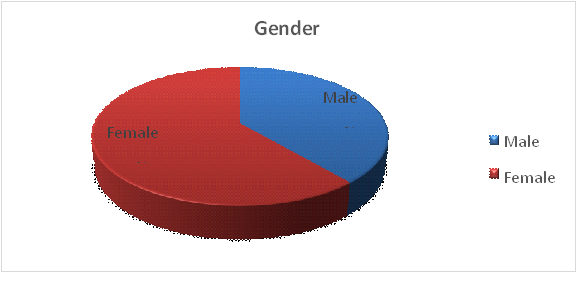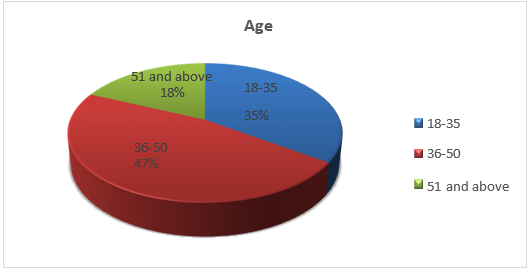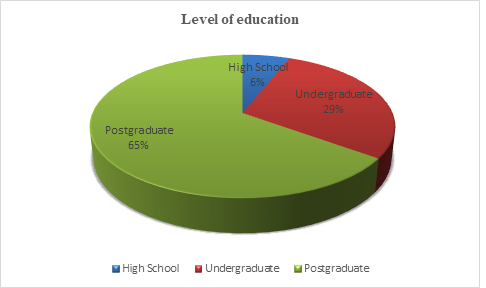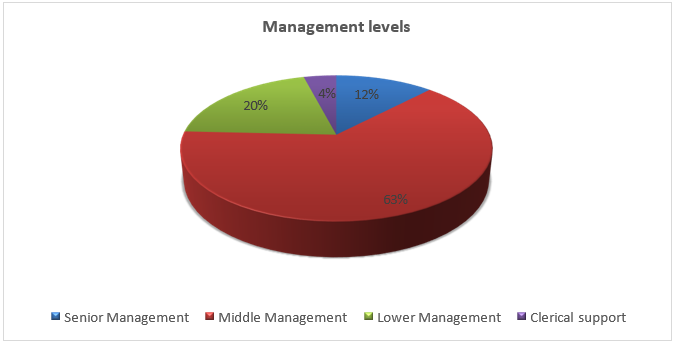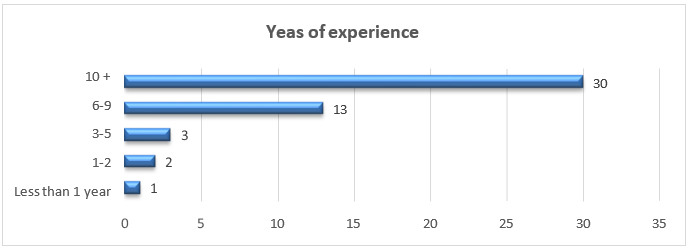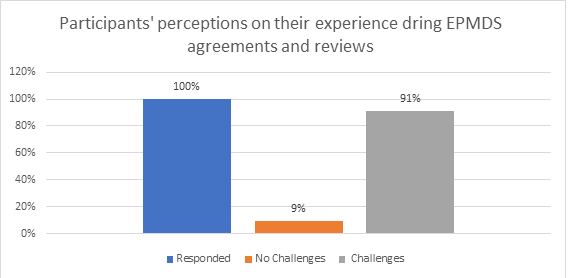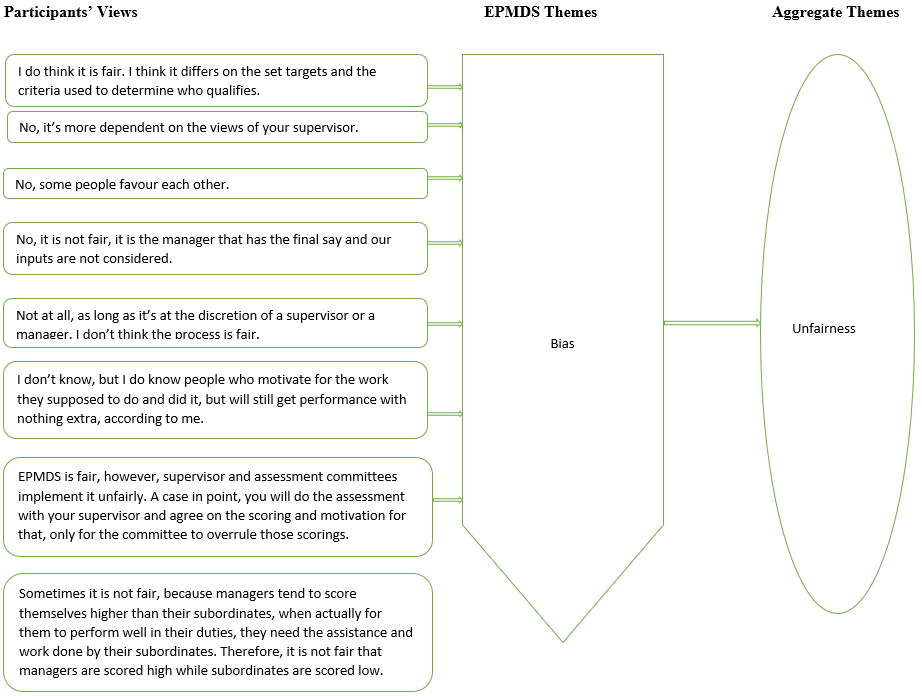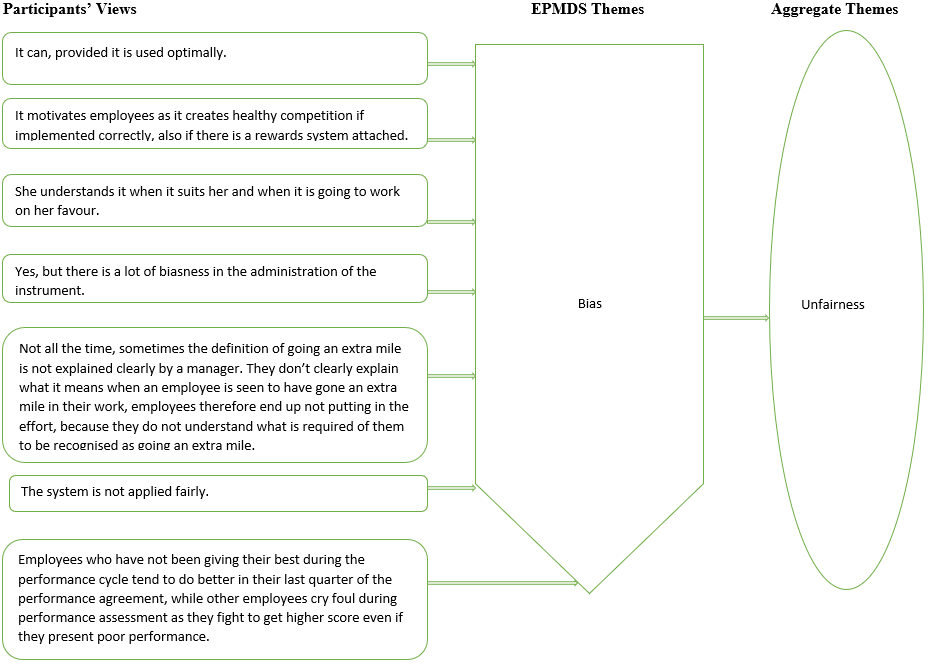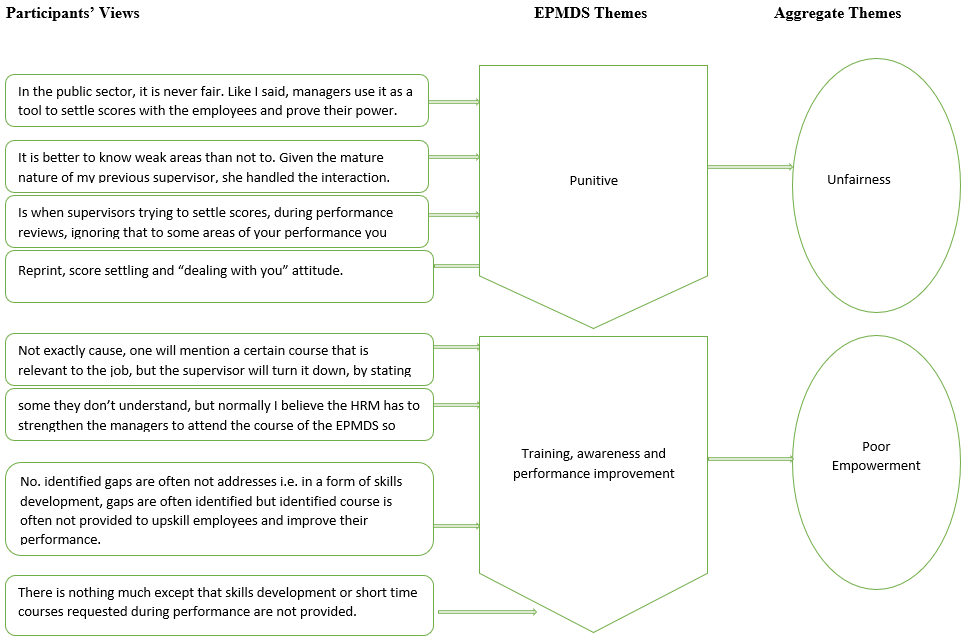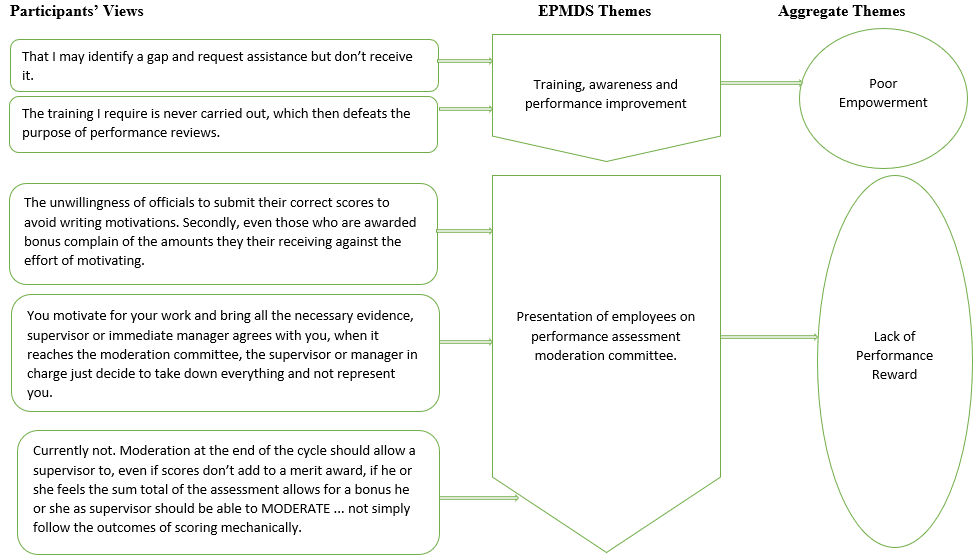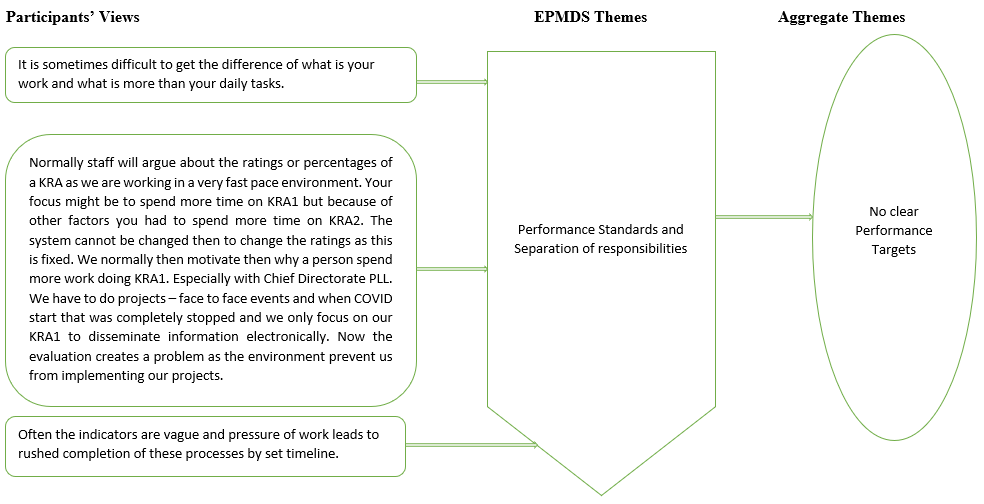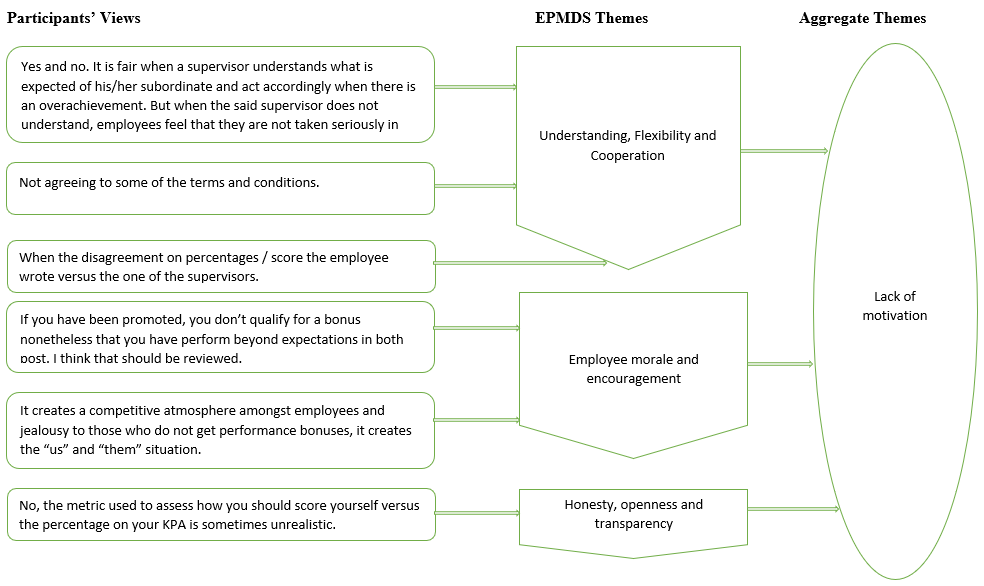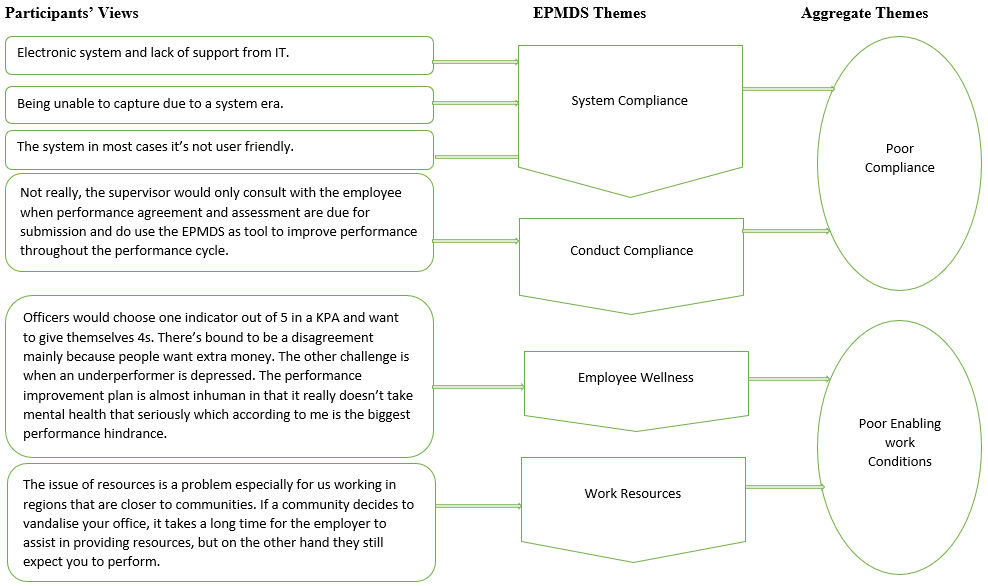Employee Perceptions: Disjuncture between Goals of Performance Management Systems and Effective Implementation in South Africa
- Nuku Eunice Mohapi
- Valery Louw
- 1998-2014
- Jan 23, 2024
- Management
Employee Perceptions: Disjuncture between Goals of Performance Management Systems and Effective Implementation in South Africa
Nuku Eunice Mohapi1 & Valery Louw2
1University Of South Africa
2Department Of Public Administration and Management, University of South Africa
DOI: https://dx.doi.org/10.47772/IJRISS.2023.7012154
Received: 11 December 2023; Revised: 18 December 2023; Accepted: 22 December 2023; Published: 22 January 2024
ABSTRACT
This study sought to investigate employee perceptions of the implementation of the Employee Performance Management Development System in a South African government department. Quantitative and qualitative data were collected from employees in the department in the form of an on-line survey. The primary findings reveal a large gap between the goal of the system and its implementation. The results of the study indicate employees perceive the EPMDS to be an ineffective and inefficient system, largely because supervisors and managers are not implementing it objectively. As a result, employees believe the system is not fairly applied in managing their performance. The study makes a significant contribution by illuminating the misalignment between the intent of the system and its actual implementation. It also points to managerial bias and the focus on punitive action rather than rewarding performance according to goal achievement and developing future performance. A major implication of the results is that the need for a monitoring function as, as required by an EPMDS directive and framework. Employees perceive its implementation to be unfair, marked by bias and punitive measures.
Key words: performance management systems, employee development, goal setting theory, government departments
INTRODUCTION
Performance management systems are intended to ultimately improve employee performance. Organisations spend considerable time and money in designing these systems, but implementation continues to prevent them from achieving their goals. The disjuncture between the promise of such systems and actual implementation is a problem for both the private and public sectors. In the case of public service in South Africa, there is anecdotal information public service employees are not happy with the EPMDS and the way it is implemented. An effective and efficient EPMDS is essential to ensure that both individual public service employees and the organisation are on the same page in terms of its priorities. The ability of the public service to achieve set goals and objectives through the effective management of employee performance ultimately impacts service delivery and the quality thereof (Productivity SA, 2007, p. 27).
Previous scholars have argued that poor implementation and monitoring of the EPMDS has a great negative impact on service delivery in the public service. According to (Werner, 2011, p. 117), the barriers that hinder the effective implementation of EPMDS include (a) not enough feedback on individual performance, (b) not enough manager support, (c) not enough resources and (d) no incentives. Well-designed EPMDS include measures to eliminate the above-mentioned barriers and deliberates on how the manager and the employee must work together to improve employee performance. Clardy (2007, p. 339) states that barriers to the implementation of EPMDS in organisations include (a) lack of appropriate principles for performance management and development, (b) poor alignment of performance management processes with the strategic goals and (c) risks of ratter’s errors in performance appraisals. De Cenzo and Robbins (2009, p. 119) explain that an employee’s behaviour is based on the perception of the reality and may be influenced by the perceiver’s attitudes, motives, interests, experience and expectations.
The employees’ perceptions on EPMDS have been detected on a number of research studies that have been conducted on the effectiveness and the efficiency of the EPMDS in the public service, in almost all the public service organisations and in all three spheres of government by scholars such as (Kuk, Banning and Amey, 2010; Nzuve and Monica, 2011) and last but not least, (Panimalar & Kannan, 2013). However, not enough attention has been given to evaluating the extent to understanding whether employees believe the directives and frameworks of the EPMDS are linked to their actual performance and the expected performance according to organisational goals. Therefore, the research focused on the perceptions of public servants about the link between the EPMDS and its intended goals.
The research uses goal-setting theory to examine employee perceptions of the alignment between organisational goals, the setting individual and the implementation of the EPMDS. According to goal-setting theory, goals that are clear, specific and challenging are more motivating than vague goals or easy goals. Aguinis (2013, p. 16) argues that the process of developing individual measures starts by taking the strategy of the organisation and cascading the strategic objectives down through the diverse departments. The EPMDS requires that managers use the system to not only set employees’ goals to align with those at the organisational level but to then assess their performance fairly.
A questionnaire was used to establish employees’ perceptions on the effectiveness and efficiency of EPMDS, particularly whether there is alignment between their individual goals and the organisational goals. For this study, purposive sampling was used because the PLL Chief Directorate is the heart of GCIS. EPMDS in the public service is perceived in terms of its capacity for effective and efficient public service delivery, to enable a wide range of public servants in the society to deliver on developmental goals and objectives of a country (Issa, 2010, p. 2).
LITERATURE REVIEW
The EPMDS was introduced in the South African public service in 2001, through the Public Service Regulation 2001, for all public service senior managers and employees other than members of Senior Management Services. In fact, the system was developed to assist in providing a fair and equitable platform upon which to identify under-performance and reward good performance. Therefore, as stated in the Public Service Regulation 2001, the Performance Management and Development System is aimed at providing a framework for performance improvement and development and creates linkages between individual performance and organisational performance to improve service delivery.
DeNisi and Murphy (2017, p. 421) explain that EPMDS refers to a wide variety of activities, regulations, directives, frameworks, policies, procedures and interventions designed to help employees to improve their performance. These activities begin with performance appraisals but also include feedback, goal setting and training, as well as reward systems. Therefore, performance management systems begin with performance appraisal, then focus on improving individual performance in a way that is consistent with strategic goals and with the ultimate goal of improving an organisation’s performance.
Performance management aims to ensure each executive authority for each department needs to determine a system for EPMDS and that employee performance is a continuous process, aimed at positively influencing employees’ behaviours for the achievement of strategic goals (Aguinis, 2013, p. 2). The need to measure performance measurement internally and by stakeholders were outlined, including the improvement of accountability, strategic planning and goal setting, decision-making, and long-term goals and objectives. The heads of organisations, senior managers and other employees should all be measured. It would determine the correct activities, enhance efficiency, and understand and manage performance within an agreed framework of planned goals, objectives, indicators and support incentives.
Singh and Twalo (2015, p. 9) suggest that an ideal EPMDS in the public service must help individuals to acknowledge their weaknesses, realise their strengths and improve their skills, knowledge and attitudes. Moreover, it should motivate an individual’s career growth through training and development. It should also assist managers in identifying shortfalls and gaps in employment regulations, procedures and practices. It is critical for any organisation to know and understand the way in which its employees perceive the efficacy of the performance management system in place, since perceptions influence people’s judgements and attitudes towards a particular phenomenon. The extant literature on performance management indicates that when employees experience difficulties with the system, they are likely to form negative perceptions, which can ultimately affect their performance at large (Fakharyan, Jalilvand, Dini & Dehafarin, 2012, p. 1-9)
Perception is described by (Warokka, Gallato and Moorthy, 2012) as a process whereby individuals organise and interpret their sensual impressions in order to give meaning to their environment. The intentions often differ, since every individual has different behaviours and thoughts. Generally, employees’ perceptions are confined by the organisational justice in the workplace and if they perceive the performance management system to be unjust or unfair, it is likely to negatively impact on their work performance and vice versa (Ketelaar & Koenig, 2007; Warokka et al., 2012). Consequently, individuals will only be satisfied with a performance appraisal process that accomplishes the criteria of fairness, which is expressed by many researchers as organisational justice (Warokka et al., 2012).
Managers are in a better position to identify when employees have wrong perceptions of employers about performance management, through communication and consultation. Knowledge of this can allow them to influence employees towards positively supporting organisational objectives. Elgana (2012, p. 57) is of the opinion that what managers need is an understanding of how this factor affects a person’s view of the work environment. De Cenzo and Robbins (2009, p. 119) explain that an employee’s behaviour is based on the perception of the reality and may be influenced by the perceiver’s attitudes, motives, interests, experience and expectations. There are various elements within both the work environment, encompassing factors like the social context and timing, and elements associated with the subject, including aspects such as newness, movement, auditory stimuli, dimension, backdrop, closeness, and resemblance, collectively impact employee conduct (Oberoi & Rajgarhia, 2014, p. 3). Being able to identify and understand different perceptions of employees can assist managers in implementing measures and systems to address negative perceptions, which can have adverse effects on the performance of employees and the overall organisational performance. Though effective and efficient processes are important in any EPMDS, the human factor is the most important component, indicating whether employees perceive the system as effective and efficient. The relationship between an employee and his/her manager is the key factor in driving those perceptions (Oberoi & Rajgarhia, 2014, p. 3).
Fakharyan, Jalilvand, Dini and Dehafarin (2012) noted that performance management helps in the success of the organisation, by realising the strategic purpose, and increasing effective and efficient working processes through continuous improvement of an individual’s performance. Performance management is a process that many organisations embrace and practise, however, there seems to be a perception that the system is not being employed as intended. The system is often perceived as being biased and subjective, with irrelevant criteria being used to appraise the performance of employees. In addition, the system is perceived to be unable to provide feedback on time and there is dissatisfaction with the implementation of the process. As a result, these perceptions of the system have a negative impact on the performance of the organisation and its employees.
As the researcher briefly highlighted in the introduction above, the process of developing individual measures starts by taking the strategy of the organisation and cascading the strategic objectives down through the diverse departments. Once managers of the different departments have set their goals and objectives, each person in the department should be assisted by means of a cooperative goal-setting session to set his or her goals and the associate measures (Aguinis, 2013, p. 16). Negative perceptions of employees result in the perceived outcomes of the system not being realised. Rajendran (2008) agreed and stated that once there is a negative perception, there is a significant influence on the overall job dissatisfaction of employees and a decrease in the expected work outcomes in the form of work performance, commitment and turnover intentions.
Employees are more likely to be receptive and supportive of the performance management system if they perceive the process as a useful source of feedback that helps to improve their performance (Mullins, 2007). The way in which employees perceive the system has an overall effect on the success of the system and the organisation. The outcome of a performance management system for employees and the organisation should include commitment, job satisfaction and improved organisational performance.
Naidu, Joubert, Mestry, Masoge and Ngcobo (2009, p. 9) states that factors such as the feeling of being an important and integral part of the workplace, recognition, and the sense of belonging, all contribute to employee morale and productivity.
Cho and Lee (2012, p. 6) add that employees of organisations that have higher morale arrive on time for work, communicate better, waste less time on gossip, have higher rates of retention and are more creative. This is underscored by (Lee, Scheunemann, Hall and Payne, 2012, p. 5) who argue that it is evident that employee morale is very important in organisations, and if not effectively and efficiently managed, it can have adverse effects on the overall productivity and performance of organisations. Lee, et al., (2012, p. 5) also hold that motivation is a contributor to employee morale.
Goal setting theory
Goal setting theory was used as the framework for understanding the importance of linking organisational goals to individual performance goals as part of EPMDS. According to goal setting theory, a specific goal or target increases a person’s focus on what is to be accomplished versus not having one (Latham, Borgogni & Petitta, 2008). A number of empirical studies have shown positive effects of goal setting on an employee’s or a team’s performance (Locke & Latham 1990a). According to (Latham et al.,2008) ambitious goals and strong self-confidence inspire individuals to seek out strategies that will guide them towards achieving those goals. The impact of ambitious goals on performance is influenced by factors such as one’s abilities, dedication, feedback, situational variables, and whether the job is seen by the employee as conducive to personal growth. Sari (2018) also states that goal-setting theory underscores a crucial link between performance and goals. Essentially, this theory suggests that organisational leaders set objectives, which are then communicated to all employees through a collaborative goal-setting process. Building on Sari’s perspective (Singh, 2010) also underscores that employee and manager performance is evaluated based on the organization’s established goals and targets. The essence of the goal-setting theory’s motivation is to grasp how the establishment and pursuit of precise, demanding objectives can efficiently propel individuals towards greater performance and accomplishment, as elucidated by Steers, Mowday, and Shapiro in their 2004 research.
RESEARCH DESIGN AND METHODOLOGY
This study utilised a survey comprising both closed and open-ended questions, each possessing distinct advantages and drawbacks. Seliger and Shohamy (1989) as cited in (Zohrabi, 2013, p. 254) argue for the efficiency of closed-ended questions due to their straightforward analysis. Conversely (Kumar, 2005, p. 132) contends that closed-ended questions provide predetermined answer options, requiring participants to choose the category that best fits their response.
According to (Van Elst, 2018) quantitative analysis relies on the application of statistical methods. Statistical analysis can be broadly categorised into two main types: (1) descriptive statistics and (2) inferential statistics. Descriptive statistics primarily concern with portraying the characteristics of the sample size, whereas inferential statistics are geared towards making predictions about the entire population. For the specific focus of this study, descriptive statistics take precedence over inferential statistics, as the study employs a purposive sampling method which gave focus on the sampled size. During data collection the GCIS population size was 418 (GCIS Annual Report, 2020, p. 70). The number of employees in the Chief Directorate: Provincial and Local Liaison was 110, which was used as a sampling size from the entire population. The study purposively targeted individuals from remunerations level 2 to 14 who are familiar with the EPMDS implementation and were categorized as follows:
Levels 13-14 (11 participants): SMS responsible for planning and formulating strategies.
Levels 9-12 (63 participants): Middle management involved in planning, formulating strategies, and implementing planned programs and projects.
Levels 6-8 (28 participants): Operational and junior management employees responsible for implementing programs and projects.
Levels 2-5 (8 participants): Clerical support staff to the Chief Directorate.
A total of 110 online questionnaires were distributed, with 51 participants completing them. However, two respondents no longer fell within the chosen sampling categories and were excluded from the analysis. Therefore, the perspectives presented in the analysis are based on the remaining 49 participants. While quantitative data underwent processing using the Statistical Package for the Social Sciences, facilitating numerical presentation through figures and tables, qualitative data analysis focused on identifying common themes in participants’ descriptions of their experiences.
Research instrument
A questionnaire consisting of closed and open-ended questions was used to assess participants’ perceptions of the effectiveness of the system and its fairness. The open-ended questions allowed participants to voice their views and perceptions openly, without restricting them to particular questions or leading questions (McMillan & Schumacher, 2010, p. 323). For example, one of the closed ended questions was, “are you experiencing challenges during EPMDS agreements and performance reviews” and the open-ended questions was, “What are the challenges currently experienced in EPMDS?” Please motivate your answer.”. The questionnaire also contained questions about the demographic profile of participants (i.e., job level, seniority, etc.). The questionnaire was administered online using Google Forms. The online link to the questionnaire was sent via e-mail to the prospective participants, to give their views and perceptions of EPMDS. This approach allowed the researcher to maintain the anonymity of participants.
The necessary permission was obtained from the GCIS and participants gave consent to voluntary participate in the study after they were informed about the purpose of the study. Respondents were assured of their right to privacy and that their identity would remain anonymous. The researcher ensured that no unethical tactics and techniques were used during the sending of the online link to the questionnaire, and that participants were treated with dignity and respect. Ethical clearance was approved through the authors’ university. The also granted ethics approval for the researcher to proceed with the study, after complying with all university requirements to conduct research. According to (Hennink, Hutter and Bailey, 2011, p. 63) individual participants should be provided with sufficient information about the research, in a format that is comprehensible to them and make a voluntary decision to participate in the research study. For this reason, all purposefully sampled participants in this study were provided with a written consent letter, as part of the online questionnaire, explaining the purpose and value of the research study. The informed consent letter or form also harnessed an understanding between the researcher and the participants at the early stages of fieldwork in this study (Hennink et al., 2011, p. 192).
The researcher enhanced confidentiality by ensuring that the electronic data is stored on the researcher’s laptop computer, where only the researcher has a password to access it.
Data analysis
- Data from the closed end questions was processed through the Statistical Package for the Social Sciences (SPSS). This resulted in descriptive statistics that were used to summarise responses and to prepare graph for interpretation. A content analysis approach was used to analyse the responses to the open-ended questions. Participants answers to the questions were carefully read and group into positive perceptions or negative perceptions. Thereafter, the researcher identified common themes across the sample.
PRESENTATION OF FINDINGS
Figure 5.1 below shows that regarding the demographic composition of participants, 39% were male, and 61% were female.
Figure 5.1 Gender discretion of participants
Figure 5.2 below examined the age distribution, 35% fell within the 18-35 years range, 47% were in the 36-50 years bracket, and 18% were aged 51 and above.
Figure 5.2 Age distribution
Figure 5.3 below shows an analysis of educational backgrounds of participants of this study, 6% held a high school qualification, 29% had completed an undergraduate degree, while the majority (65%) possessed postgraduate degrees or diplomas.
Figure 5.3 Educational backgrounds
Regarding occupational levels figure 5.4 below elaborates that, 12% held senior managerial positions, 63% were in middle management, 20% occupied lower management roles, and 4% were clerical support staff.
Figure 5.4 Occupational levels
Figure 5.5 below shows that in terms of professional experience, 61% reported to have 10 or more years of experience, 27% had 6-9 years, 6% had 3-5 years, 4% had 1-2 years, and 2% had less than one year of experience.
Figure 5.5 professional experiences
Overall perceptions of participants in the PLL Chief Directorate: From the 100% of participants who responded to the question on the challenges that employees are facing with the EPMDS in the Chief Directorate, 9% are experiencing no challenges during EPMDS agreement and reviews, while 91% are experiencing challenges.
The analysis above shows that the majority of respondents are experiencing more challenges in the EPMDS agreements and reviews. These respondents are not happy with the way EPMDS agreements and reviews are conducted in the Chief Directorate. Some of the concerns they raised are quoted below.
Participant 1 “Often the indicators are vague and pressure of work leads to rushed completion of these processes by set timeline.”
Participant 2 “Officers would choose one indicator out of 5 in a KPA and want to give themselves 4s. There’s bound to be a disagreement mainly because people want extra money. The other challenge is when an underperformer is depressed …”
Participant 3 “That I may identify a gap and request assistance but don’t receive it.” Supported by another participant stating that “the training I require is never carried out, which then defeats the purpose of performance reviews”.
Participant 4 “The issue of resources is a problem especially for us working in regions that are closer to communities …”
Participant 5 “The challenge is when your supervisor requires a motivation for the work that you did. The motivation part is irrelevant as it undermines the performance, rather rely on the narrative in motivation.”
Participant 6 “Sometimes people think it’s about money and they don’t want to motivate for the extra work done because they say the money is too little anyway …”
Supported by Participant 7 stating that “the unwillingness of officials to submit their correct scores to avoid writing motivations”.
Figure 1 below demonstrates that 91% of participants consider EPMDS to have challenges when signing performance agreements and conducting performance reviews, while 9% of participants do not perceive this as a challenge. Considering the views of participants in Figure 1, it is perceived by the researcher that managers and employees do not share the same sentiment on EPMDS matters.
Figure 1: Responses of participants’ perceptions on experiences during EPMDS agreements and reviews
Reasons of participant perceptions on experiences during EPMDS agreements and reviews
The open-ended questions allowed participants to voice their views and perceptions openly, without restricting them to particular questions or leading questions. Figure 2 contains the results of the content analysis of the participants views along with the resulting themes. The researcher developed first order themes and aggregate themes to provide a consolidated view of participants’ perceptions of the EMPDS.
Eight themes were identified from participants’ narrative responses to the open-ended questions.
Unfairness: Participants described the manner in which supervisors and managers are able to manipulate the system by being biased and punitive, without being subjected to consequence management and the unfairness leads to the ineffectiveness of the EPMDS system.
Poor empowerment: Participants did feel empowered. Although participants would identify training interventions to improve their performance, they were not being implemented by the managers and the training department.
Lack of performance rewards: Supervisors, managers and the assessment moderation committees were described as being inconsistent in the manner in which they apply the system, especially when awarding performance rewards to the employee. Participants believed managers and supervisors have multiple standards for assessing the same group of employees.
No clear performance targets: Data demonstrated that employees are not given clear targets. Consequently, managers are able to set random targets, as and when they feel like, during the course of the performance cycle. This causes challenges for employees as they are expected to perform according to their signed performance agreements but instead have to deal with moving performance targets.
Lack of motivation: Participants believe the lack of ability of supervisors and managers to treat employees equally gives rise to demotivation and unnecessary tensions amongst employees. Demotivation also leads to the organisation not being able to meet the set organisational outputs/targets.
Poor compliance: The departmental generated computer systems to assist in improving the effectiveness of the system are also not helpful. Instead, the systems are frustrating employees even further. Managers and supervisors are also not effectively using the process by not continuously giving feedback to the employees. Instead, they wait to do so during the assessment period.
Poor enabling working conditions: Participants feel supervisors and managers do not care about the wellness of employees. Further, employees are expected to deliver while the required resources are not provided.
Figure 2: Data structure of open-ended questionnaire
DISCUSSION
This section discusses the major findings and makes recommendations for how the EMPDS can be improved.
Poor performance management training: Previous research has demonstrated the importance of training managers for the effective implementation of performance management systems. Performance management training is considered important in attempting to implement an effective EPMDS in the organisation. Performance management training enables individuals not only to understand the rationale behind the system, but also to understand its aim, objectives and how it is supposed to be implemented. One of the challenges that organisations face is that some of the supervisors are not implementing the policy effectively, because they do not fully understand it. It is the responsibility of the HR managers, in this regard, to take lead of the training at all levels in the organisation, as an initiative to improve the implementation of the EPMDS and also to fulfil the requirements of the EPMDS legislated frameworks on the training of all employees. Furthermore, some of the respondents are of the view that managers and supervisors are not taking the system seriously. In this case, training on performance management and consequence management could be a solution in addressing the knowledge and skills problem, as well as non-compliance with the requirements of the system.
Subjectivity: One of the findings of this study is that managers in the Chief Directorate are not sufficiently fair in the manner in which they conduct performance appraisals. Some respondents mentioned that the results of the appraisals are often not a true reflection of the performance of employees but are based on biased supervisor-subordinate relationships. The managers decide to score employees well or badly based on whether they like the employees on a personal level.
Negative perceptions about the performance assessment moderating committee: The main concerns raised by employees about the management and implementation of the EPMDS are the changing of scores by the moderating committee without the consent of the employees concerned, and inability of the supervisors and managers to defend the scores agreed upon at the moderation committee, whilst they are the ones who witnessed the performance, since they daily managed and monitored it. This is demotivating as employees are surprised by the changes in the scores, which they agreed upon with their direct supervisors. Respondents reported that the judgements of the moderation committee are not consistent with the outcomes derived from performance appraisals. Some outcomes are unfairly favourable to specific individuals and this shows biasness, and victimisation of employees by managers seems to be a common factor affecting employees’ performance in the Chief Directorate. This research shows that both supervisors and subordinates are not honest and open with each other. Some participants are of the view that some managers and supervisors favour certain employees, while other managers and supervisors use the process to settle scores with subordinates who are not in agreement with them. Some supervisors feel threatened by subordinates. Subordinates use the process as a means of getting extra money through performance bonuses. The performance assessment period is viewed as a period of high tension between supervisors and subordinates.
Lack of honesty and integrity: The findings revealed that a lack of professional ethics and integrity could compromise the effective implementation of the EPMDS in government departments. The ethics and levels of honesty and integrity need to improve in the system of administering the EPMDS. All public servants and their managers need to have a mind shift when it comes to implementation of the EPMDS. They should have an attitude geared towards implementing it with integrity and honesty.
Poor training and development: Employees in the Chief Directorate do not receive the required training to improve their performance. There are budgetary training constraints in the organisation and, as a result, training intervention identified by participants in their personal development plans and performance improvement plans are not implemented in the Chief Directorate; employees are expected to perform at an expected standard without being provided with the required training.
Poor communication and feedback on employee performance results: Another finding of this study is that communication and feedback on the performance results of the individual employees is of the utmost importance and needs to improve significantly. Managers should ensure that they constantly communicate with their subordinates about their performance results and inform them about those areas that require improvement. Due to goals and expectations being unrealistic and poorly defined, employees feel demotivated and discouraged. Similarly, feedback is not delivered in a constructive and supportive manner and leads to resentment of the EPMDS and conflict.
Lack of alignment of the EPMDS directives, organisational targets and the individual performance agreements: One of the findings for non-effective implementation of EPMDS and poor service delivery is that there is no link between EPMDS directives and frameworks, the organisational goals and the actual individual performance. This gap created a huge backdown on service delivery matters. The Department of Public Service and Administration (DPSA), as the custodian of the framework and the EPMDS developer, does not have a mechanism in place to monitor whether the directives and frameworks developed are used correctly and produces the required results; hence, managers and supervisors are able to manipulate the system to serve their personal interests.
CONCLUSION
The purpose of this article was to assess the perceptions of employees in the PLL Chief Directorate in the GCIS, on the effectiveness and efficiency of the EPMDS and its implementation. The imperial findings above clearly show that employees in the PLL Chief Directorate of the GCIS have a perception that the EPMDS and its implementation is not fair, but primarily biased and punitive. The results of this study are similar to that of (Singh and Twala, 2015) that found that a poorly implemented EPMDS fails to motivate employees in the organisation and, inevitably, their lack of job satisfaction will impact negatively on their self-esteem. Singh and Twalo (2015) study also reveal that when employees’ expectations are not met, inappropriate job behaviour and performance can derail the attainment of an organisation’s goals. The present study, however, provides more depth to understanding what factors employees perceive to be poorly implemented in the EPMDS. The findings also provide organisations with the areas that need to be improved to enhance the effectiveness of the EPMDS. These improvements could go a long way to influence how employees experience the implementation of the EPMDS. A better alignment of employee performance targets to organisational goals is an imperative. Further, a monitoring function should be implemented to ensure the system is used effectively. When implemented well, a good EPMDS would provide critical information that would allow an organisation to make sound decisions regarding their people resources. Hence, there should be no room to compromise the use of a well-developed EPMDS to achieve the strategic objectives of any organisation. Undoubtedly, a good EPMDS can be a powerful tool to drive organisational effectiveness and change.
The findings of this study will assist the PLL Chief Directorate managers and the GCIS, as an organisation, to consider management styles and enhance their understanding of the simulated significance of employee perception of the EPMDS, and its consequences on employees’ morale and levels of commitment to the organisation. The findings will also assist the GCIS to go back to the drawing board, check the organisation’s alignment with the directives and uphold the goal-setting mentality when planning for the organisational targets.
This study, like any other study, has its limitations. The PLL Chief Directorate is one section amongst many in the GCIS and the findings may not be generalised for the organisation. Due to the Covid-19 pandemic, some employees in the PLL Chief Directorate of the GCIS did not have access to resources while working from home. The researcher had to allow longer time than anticipated for the participants to return to the workplace and access the resources, such as computers and internet, to be able to complete the online questionnaire.
The findings of this study opened another future research question: if managers are consistently getting away with not implementing the system properly and being punitive, what is the system developer’s role, which is the DPSA, in ensuring proper monitoring of the implementation of the system and its outcomes? Further research is needed to understand the challenges that managers may be facing in implementing the system. This type of research may provide a holistic understanding of how to ultimately improve the implementation of the EPMDS.
REFERENCES
- Aguinis, H. (2013). Performance management. Third edition. United States of America: Pearson Education.
- Chandrasekar, K. (2011). Workplace environment and its impact on organisational performance in public sector organisations. International Journal of Enterprise Computing and Business Systems, 1(1), 1-18. Available from: http://www.ijecbs.com. (Accessed 12 January 2012).
- Cho, Y. J., & Lee, J. W. (2012). Performance management and trust in supervisors. Review of Public Personnel Administration, 32(3), 236–259. doi:10.1177/0734371X11421496
- Clardy, A. (2007). Strategy, core competencies and human resource development. Human Resource Development International, 10(3), 339-349.
- De Cenzo, D.A. and Robbins, S.P. (2009). Human resource management. Sixth edition. New York: John Wiley and Sons, Inc.
- DeNisi, A.S. and Murphy, K.R. (2017). Performance appraisal and performance management: 100 years of progress? Journal of Applied Psychology, March 2017, 102(3), 421-433.Education.
- Elgana, A.A. (2012). The impact of perception on work behaviour. Kuwait chapter of Arabian Journal of Business and Management Review, 2(2), 56-71.
- Fakharyan, M., Jalilvand, M. R., Dini, B., & Dehafarin, E. (2012). The Effect of Performance Appraisal Satisfaction on Employee’s Outputs Implying on the Moderating Role of Motivation in Workplace. International Journal of Business & Management Tomorrow, vol. 2, no. 4, pp. 1-9.
- Hennink, M., Hutter, I. and Bailey, A. (2011). Qualitative research methods. London: SAGE.
- Issa, F. (2010). Policy and Methodologies for Evaluating Performance of the Public Service in Tanzania. Paper Presented at an Expert Group Meeting on Human Resource Management Policy in the Public Sector in Africa held in Durban, South Africa, November 2010
- Ketelaar, T., & Koenig, B. (2007). Justice, Fairness, and Strategic Emotional Commitments. In Justice and Emotions: Current Developments, D. de Cremer (Ed.). (pp. 133-154). Lawrence Erlbaum Associates, New Jersey.
- Kruger, D.J., De Vos, A.S., Fouché, C.B. and Venter, L. (2005). Qualitative data analysis and interpretation. Third edition. Pretoria: Van Schaik Publishers.
- Kuk, L., Banning, J.H. and Amey, M.J. (2010). Positioning student affairs for sustainable change: achieving organisational effectiveness through multiple perspectives. Virginia: Stylus Publishing.
- Kumari, N. (2011). Job Satisfaction of Employees at the Workplace. European Journal of Business and Management, 3(4):11-30. Available from: www.iiste.org. (Accessed 18 March 2013).
- Latham, G. P., Borgogni, L., & Petitta, L. (2008). Goal setting and performance management in the public sector. International Public Management Journal, 11(4), 385-403.
- Lee, C., Scheunemann, J., Hall, R., Payne, L. (2012). Low Staff Morale & Burnout: Causes & Solutions. Office of Recreation & Park Resources, Department of Recreation: Sport & Tourism, University of Illinois. Available from: https://illinois.edu/lb/files/2012/06/01/39974. pdf. (Accessed 28 March 2013).
- Leedy, P.D. and Ormrod, J.E. (2010). Practical research: planning and design. New Jersey: Merrill Prentice-Hall.
- Mawoli, M.A. & Babandako, A.Y. (2011). An Evaluation of Staff Motivation, Dissatisfaction and Job Performance in an Academic Setting. Australian Journal of Business and Management Research, 1(9):1-3.
- McMillan, J.H. and Schumacher, S. (2010). Research in education: evidence-based inquiry. Seventh edition. Boston: Pearson Education, Inc.
- Mullins, L.J. (2007). Management and organisational behaviour. Harlow: Pearson
- Mulvaney, M.A., McKinney, W.R. and Grodsky, R. (2012). The development of a pay-for performance appraisal system for municipal agencies: a case study. Public Personnel Management, 505-533.
- Naidu, A., Joubert, R. Mestry, R., Mosoge, J. and Ngcobo, T. (2009). Educational management and leadership: a South African perspective. Cape Town: Oxford University Press, Southern Africa (Pty) Ltd.
- Nzuve, S.N.M. and Monica, N.N. (2011). An assessment of employees’ perception of the performance appraisal: a case study of the Department of Immigration – Nairobi. http://ssrn.com/abstract=2192862. Date of access: 17 May 2014.
- Oberoi, M. and Rajgarhia, P. (2014). What your performance management system needs most. http:// businessjournals.gullup.com: New York. Date of access 15 March 2014.
- Panimalar, M. and Kannan, K. (2013). A study of employee perceptions towards effectiveness and impact of environmental management systems at Tamil Nadu Cooperative Textile Processing Mill. Journal of Business Management and Social Sciences Research, 2(1), 2319-5614. www.borjournals.com. Date of access: 10 October 2013.
- Productivity SA. (2007). Public sector performance: Productivity and service delivery in South Africa. Midrand: Productivity SA.
- Rajendran, V. (2008). The relationship between performance appraisal satisfaction and employee outcomes: a study conducted in peninsular Malaysia (Doctoral dissertation, University of Malaya).
- Senyucel, Z. (2009). Managing Human Resources in the 21st Century, London: Ventus Publishing ApS.
- Singh, P. and Twalo, T. (2015). Effects of poorly implemented performance management systems on the job behaviour and performance of employees. International Business and Economics Research Journal, 14(1), 79-94.
- Society for Human Resource Management (SHRM) Research Quarterly (2010). Motivation in Today’s Workplace: The Link to Performance. Available from: http://www.shrm.org/research/articles/articles/documents/10-0235%20 research %20 quarterly-q2-fnl.pdf. (Accessed 31 October 2014).
- South Africa. (2001). Public Service Regulation 2001. Pretoria: Government Printers.
- Sridevi, M.S. and Markos, S. (2010). Employee engagement: the key to improving performance. International Journal of Business and Management, 5(12), 89-96. Available from: http://www.myopinionatbesix.com/BesixSurvey/media/Besix-Survey/pdf/4.-Employee-engagement-The-Key-to-Improving-Performance.pdf. (Accessed 22 September 2013).
- Strydom, H. (2006). Ethical aspects of research in the social sciences and human service professions. In: De Vos, A.S., Strydom, H., Fouche, C.B. and Delport, C.S.L. (Eds.). Research at grassroots level: for social sciences and human services professions. Pretoria: Van Schaik.
- Steers, RM. Mowday, RT. and Shapiro, DL. (2004). The future of work motivation theory. Academy of Management Review, 29(3): 379-387. https://doi.org/10.5465/amr.2004.13670978
- Sundaray, B.K. (2011). Employee engagement: a driver of organizational effectiveness. European Journal of Business and Management, 3(8), 53-59. Available from: www.iiste.org. (Accessed 22 September 2013).
- Van Elst, H. (2018). An introduction to inductive statistical inference: from parameter estimation to decision-making Preprint arXiv:1808.10137v1 [stat.AP]
- Wagner, C., Kawulich, B. and Garner, M. (2012). Doing social research. A global context. Maidenhead: McGraw-Hill.
- Warokka, A., Gallato, C. G., & Moorthy, T. (2012). Organizational Justice in Performance Appraisal System and Work Performance: Evidence from an Emerging Market. Journal of Human Resources Management Research, vol. 1, no.1, pp. 1-18.
- Welman, J.C. and Kruger, S.J. (1999). Research methodology for business and administrative sciences. Cape Town: Oxford University Press.
- Werner, A. (2011). Organisational behaviour: a contemporary South African perspective. Third edition. Hatfield: Van Schaik Publishers.

